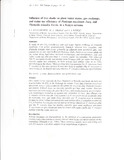| dc.contributor.author | J. I, Kinyamario | |
| dc.contributor.author | M.J, Trlica | |
| dc.contributor.author | T. J, Njoka | |
| dc.date.accessioned | 2013-02-26T10:43:24Z | |
| dc.date.issued | 1995 | |
| dc.identifier.citation | Afr. J. Ecol. 1995, Volume 33, pages 114 123 | en |
| dc.identifier.uri | http://erepository.uonbi.ac.ke:8080/xmlui/handle/123456789/11630 | |
| dc.description.abstract | A study of net co. assimilation rate and water vapour exchange of panicum
maximum that grows predominantly beneath savanna tree canopies, and
Themeda triandra that grows primarily in adjacent open grassland sites, was
carried out on both sites in Nairobi National Park. Panicum maximum exhibited
less water stress, had lower stomatal conductance and transpiration, and had
higher water use efficiency than T. triandra under tree canopies. This indicated
that P. maximum should accumulate more biomass with less water loss than Z.
triandra under tree canopies, as both grasses had similar rates of net co,
assimilation in the shade. More grazing selection pressure for p. maximum thai
T. triandra in the open grassland may also help to explain why p. maximum is
more dominant in shaded habitats; whereas, T. triandra dominates open habitats.
Key words: grasses, photosynthesis, net assimilation rate | en |
| dc.language.iso | en | en |
| dc.subject | Grasses | en |
| dc.subject | Photosynthesis | en |
| dc.subject | Net assimilation rate | en |
| dc.title | Influence of tree shade on plant water status, gas exchange, and water use efficiency of Panicum maximum Jacq. and Themeda triandya Forsk. in a Kenya savanna | en |
| dc.type | Article | en |
| local.publisher | Department of Botany, University of Nairobi, | en |
| local.publisher | Department of Range Science, Colorado State Llniyersity, Fort Collins, Colorado 80523, USA | en |
| local.publisher | Department of Range Management, lJniversity of Nairobi | en |


